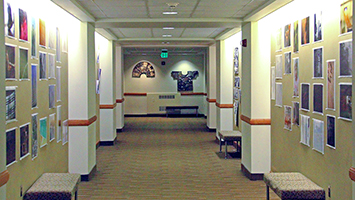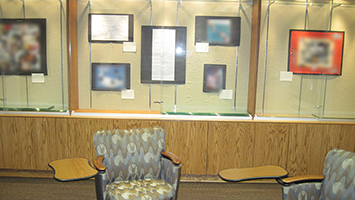


The Residential College in the Arts and Humanities (RCAH)
The RCAH offers a four-year interdisciplinary arts and humanities major defined by the four "cornerstones" of world history, art and culture, ethics, and engaged learning. Having received its inaugural cohort of students in fall 2007, the RCAH is relatively new. Instruction is provided primarily through an interdisciplinary, tenure-system faculty. In addition to courses in writing, history, and culture, students take "creative workshops" (courses devoted to some form of creative production, including visual art, performance, media, or creative writing) as well as courses in civic engagement (which place them in community settings).
All RCAH facilities are located in the Snyder-Phillips Residence Hall Complex, one of the older residence halls on Michigan State University's campus. Students are required to live in Snyder-Phillips during their first year and have the option of living there in subsequent years. College facilities include eight classrooms, an art gallery called LookOut! Gallery (figures 5.9 and 5.10), an art studio (figures 5.3 and 5.4), a 132-seat theater (figure 5.2), a music practice room, and multiple informal meeting spaces (figure 5.12). All faculty and staff, including the dean of the college, have offices in Snyder-Phillips. Many of the hallways are equipped with glass display cases and other structures for displaying compositions of various sorts, from posters to paintings (figures 5.13 and 5.14).
The Snyder-Phillips complex contains a number of additional spaces (e.g., study lounges, music practice rooms, a coffee shop) that are not under the direct administration of the college, but are nevertheless supportive of the living–learning community. One particularly important space is The Gallery, a large atrium-style cafeteria. All first-year students have a meal plan that provides unlimited access to The Gallery, which is open 7:00AM to midnight.
Each cohort of students is relatively small, ranging from 100–120 students. Students take the same five courses during their first year. In the fall semester, students take RCAH 111 Writing in Transcultural Contexts and RCAH 201 Transcultural Relations through the Ages. In the spring semester, students take RCAH 112 Writing, Research, and Technologies (which, with RCAH 111, satisfies MSU's first-year writing requirement) and RCAH 202 The Presence of the Past. In either fall or spring, students also take RCAH 192 First Year Seminar—a two-credit course focused on a topic of the instructor's choosing. The balance of student schedules is comprised of courses outside the college, including courses that satisfy university requirements in math, social science, and natural science. There are typically about five or six sections of each course; with cohorts of under 120 students, there is significant overlap between the various sections. (The RCAH curriculum has continued to evolve since this article was originally drafted; see RCAH curriculum for the latest version.)
The joke about a residential college is that you can roll out of bed and go to class in your pajamas. This joke contains a lesson about the importance of proximity in a residential program. The RCAH and other LLCs are distinguished for the way they make available a wide range of spaces—for sleeping, learning, playing, and working—under the same roof.
To sum up: the RCAH is a relatively small program comprised of students who have the same major, who have many classes in common, and who live together for at least a year in a residence hall that also includes a range of infrastructural elements supportive of their daily residential, recreational, and academic routines.
The RCAH Language and Media Center (LMC)
One of my roles in the college is to direct the RCAH Language and Media Center (figures 5.11–5.14), a suite of eight rooms on the terrace level of Snyder-Phillips. The LMC is located across the hall from the Art Studio, adjacent to a Music Practice Room, and just down the hall from the Theater. The mission of the LMC is to support media production and world-language proficiency. A central room in the LMC includes eleven computer workstations (figure 5.11). Specialized media software, such as Final Cut Pro, Photoshop, and InDesign, are installed on each workstation. The suite includes two conference rooms equipped with large display monitors that are available for users to connect to (figure 5.12). Additional spaces include a lounge area for meeting and studying (figure 5.13), storage and utility rooms, and an office for the RCAH IT specialist (a fulltime staff position). Specialized equipment used primarily on site include a large-format photo printer, two midi music keyboards, a scanner, and a digital paper cutter. The LMC loans out a range of media production equipment to students and faculty, including cameras, camcorders, lights, microphones, lightweight dollies, and more (figure 5.14).
The LMC is staffed primarily by undergraduate consultants who have been recruited for their experience in one or more types of media (video, graphic design, etc.). At least one and usually two consultants are available to support students during most open hours, with the exception of the early shifts on weekdays, which are staffed by the RCAH IT specialist. As the director of the LMC, I am charged with supervising the RCAH IT support staff member as well as recruiting, training, and supervising the student consultants.
I see the LMC as a multiliteracy center. The primary goal of the LMC is to support students as they work on multimodal projects. Knowledgeable peer consultants are available to talk with composers about all aspects of their projects, including both technical and rhetorical considerations.
Portions of the LMC are occasionally reserved for language tables, a special class, or a workshop. Apart form that, LMC users do not make appointments; they come and go as needed. Students visit when they choose, work for as long as they choose, converse as much as they choose, and leave when they choose. Because composers are often working on projects that require the specialized technologies available in the LMC, they often work for long periods of time. A student working on a video in Final Cut Pro, for instance, might need to complete the entire project in the LMC because that software might not be readily available elsewhere.